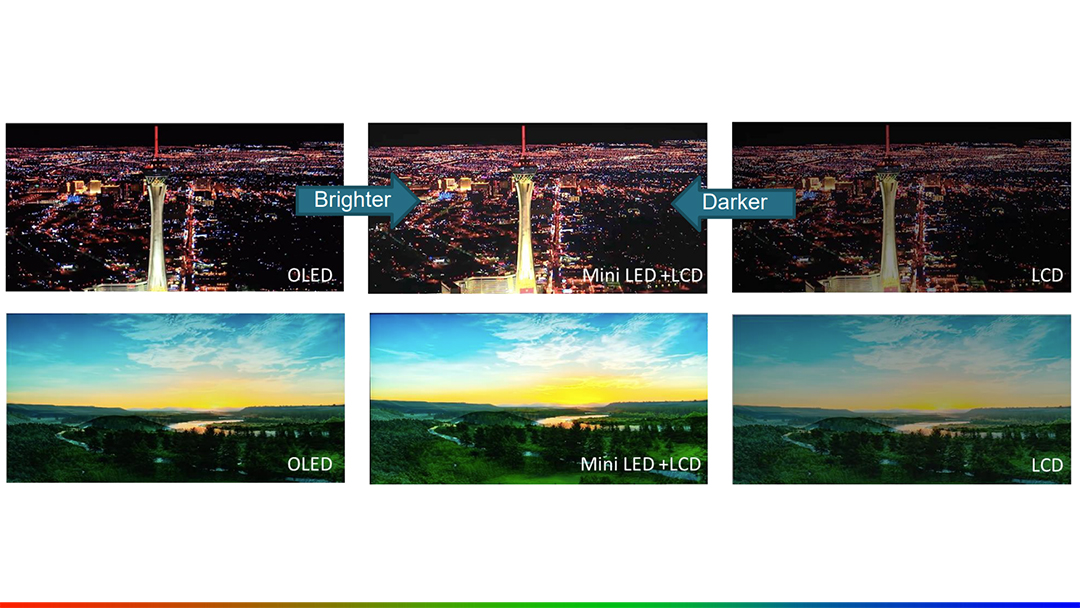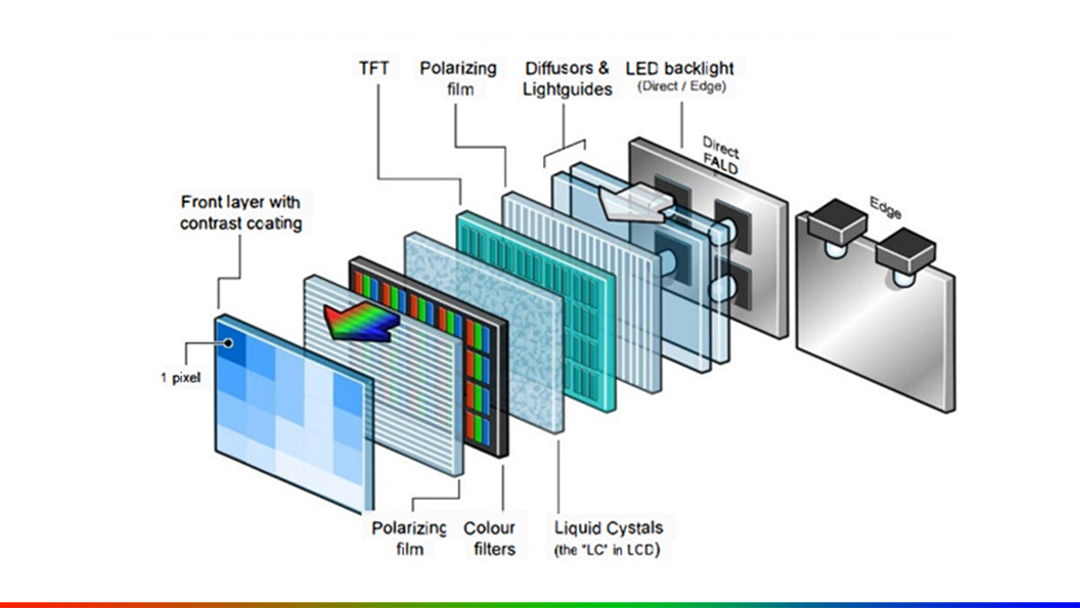Darkest black. Breathtaking contrast. Brilliant colors. A service life spanning decades. Low energy consumption. The superlatives just keep coming: FALD displays (FALD stands for full array local dimming) are among the best on the market in terms of screen technology. Up to now, they have primarily been installed in high-end TVs and premium car brands, but they are now also becoming of interest for a wide range of commercial applications.
Overshadowed by other technologies, FALD displays have grown to be the foremost innovation in the display market almost unnoticed. For example, OLED displays are significantly more well known. However, TV and monitor manufacturers and premium brands such as Mercedes, Audi, BMW, etc. are increasingly relying on FALD displays in the high-end sector. This is no surprise, as they are brilliant in the truest sense of the word due to the wide variety of benefits they offer:
• Outstanding contrast:
Selective control of the background lighting in various areas of the screen enables an extreme contrast ratio, currently of up to 10,000,000 to 1.
• High light output:
A big benefit is the high light output of FALD displays compared to OLED displays. The high level of efficiency allows them to be used outdoors and ensures good readability, even in direct sunlight – a usage scenario in which OLED technology reaches its physical limits. When comparing the light output of FALD to OLED, FALD provides approx. 200 lm/W and OLED provides approx. 100 lm/W.
• Outstanding readability:
Regardless of whether they are used in direct sunlight or in a dark room – FALD displays offer impressive performance both outdoors and indoors in any lighting conditions owing to their sharp, high-contrast, perfectly readable image.
• High color fidelity and brilliance:
FALD displays enable remarkably precise color rendering and cover an expanded color scale. There is no burn-in or color-dependent aging of any kind.
• Low heat generation:
The high-efficiency LEDs used in FALD displays minimize heat generation to an extremely low level.
• Low energy consumption:
The energy consumption of FALD displays is significantly lower than that of comparable technologies including OLED.
• Durability:
FALD displays are significantly more durable than OLED displays and LEDs have a service life of up to 100,000 h (L50 value).
FALD displays are brilliant thanks to the benefits they offer – but what about the disadvantages?
When faced with all of these benefits, a question springs to mind – what are the disadvantages of FALD displays? We asked a specialist: our CEO and owner Dieter Heimgartner. He grins: “As is often the case with outstanding technologies and innovations, the first disadvantage is the price. FALD displays have previously only been used in top-class products, meaning only the best TVs, the best PC monitors, and displays in premium vehicles benefited from the advantages that FALD technology offers.” However, this is now changing due to their market penetration, he says.
FALD displays are also ideal for your customer application
This is down to one main reason – the system costs for producing FALD displays have reduced massively. Thanks to their increasing distribution, leading display manufacturers are constantly reducing costs. Manufacturers such as MacroBlock already offer chip sets for assembling turnkey displays. It is these kinds of customized displays that can be precisely tailored to meet technical and commercial requirements which DMB Technics is now offering to customers. Dieter Heimgartner states: “The technology is becoming of increasing interest to our customers, as FALD displays not only impress in terms of their brilliance and contrast – they are also extremely durable and energy-saving. This makes them true green displays.” When asked about the possible areas of application for FALD displays, he explains: “For example, we are thinking about controls in industry, monitors for strongly varying ambient lighting conditions, smart home applications, displays for medical imaging processes and much more.”
How does a FALD display actually work?
Like mentioned above, FALD stands for “full array local dimming”, a technology that combines the strengths of OLED and LCD. Just as with a conventional LCD display, a FALD display requires background lighting with LEDs. However, it also has the LEDs distributed over the entire area of the LCD panel – in other words, “full array”. In addition, the LEDs are organized into groups known as “dimming zones”. The brightness of each one of these zones can be controlled independently of the others, depending on the image content – also known as “local dimming”. This technology enables the user to precisely control brightness and contrast and dim or brighten zones depending on the content. The result is the above-mentioned brilliant image quality with an extremely dark black level and exceptionally high contrast. In contrast to OLED, there is no burn-in, the panels last much longer and consume even less energy – but why spend so long talking about something which you can simply experience?
Call us or write to us. Our display experts will be happy to show you how FALD displays from DMB Technics can also perfect your specific application.
Darkest black. Breathtaking contrast. Brilliant colors. A service life spanning decades. Low energy consumption. The superlatives just keep coming: FALD displays (FALD stands for full array local dimming) are among the best on the market in terms of screen technology. Up to now, they have primarily been installed in high-end TVs and premium car brands, but they are now also becoming of interest for a wide range of commercial applications.
Overshadowed by other technologies, FALD displays have grown to be the foremost innovation in the display market almost unnoticed. For example, OLED displays are significantly more well known. However, TV and monitor manufacturers and premium brands such as Mercedes, Audi, BMW, etc. are increasingly relying on FALD displays in the high-end sector. This is no surprise, as they are brilliant in the truest sense of the word due to the wide variety of benefits they offer:
• Outstanding contrast:
Selective control of the background lighting in various areas of the screen enables an extreme contrast ratio, currently of up to 10,000,000 to 1.
• High light output:
A big benefit is the high light output of FALD displays compared to OLED displays. The high level of efficiency allows them to be used outdoors and ensures good readability, even in direct sunlight – a usage scenario in which OLED technology reaches its physical limits. When comparing the light output of FALD to OLED, FALD provides approx. 200 lm/W and OLED provides approx. 100 lm/W.
• Outstanding readability:
Regardless of whether they are used in direct sunlight or in a dark room – FALD displays offer impressive performance both outdoors and indoors in any lighting conditions owing to their sharp, high-contrast, perfectly readable image.
• High color fidelity and brilliance:
FALD displays enable remarkably precise color rendering and cover an expanded color scale. There is no burn-in or color-dependent aging of any kind.
• Low heat generation:
The high-efficiency LEDs used in FALD displays minimize heat generation to an extremely low level.
• Low energy consumption:
The energy consumption of FALD displays is significantly lower than that of comparable technologies including OLED.
• Durability:
FALD displays are significantly more durable than OLED displays and LEDs have a service life of up to 100,000 h (L50 value).
FALD displays are brilliant thanks to the benefits they offer – but what about the disadvantages?
When faced with all of these benefits, a question springs to mind – what are the disadvantages of FALD displays? We asked a specialist: our CEO and owner Dieter Heimgartner. He grins: “As is often the case with outstanding technologies and innovations, the first disadvantage is the price. FALD displays have previously only been used in top-class products, meaning only the best TVs, the best PC monitors, and displays in premium vehicles benefited from the advantages that FALD technology offers.” However, this is now changing due to their market penetration, he says.
FALD displays are also ideal for your customer application
This is down to one main reason – the system costs for producing FALD displays have reduced massively. Thanks to their increasing distribution, leading display manufacturers are constantly reducing costs. Manufacturers such as MacroBlock already offer chip sets for assembling turnkey displays. It is these kinds of customized displays that can be precisely tailored to meet technical and commercial requirements which DMB Technics is now offering to customers. Dieter Heimgartner states: “The technology is becoming of increasing interest to our customers, as FALD displays not only impress in terms of their brilliance and contrast – they are also extremely durable and energy-saving. This makes them true green displays.” When asked about the possible areas of application for FALD displays, he explains: “For example, we are thinking about controls in industry, monitors for strongly varying ambient lighting conditions, smart home applications, displays for medical imaging processes and much more.”
How does a FALD display actually work?
Like mentioned above, FALD stands for “full array local dimming”, a technology that combines the strengths of OLED and LCD. Just as with a conventional LCD display, a FALD display requires background lighting with LEDs. However, it also has the LEDs distributed over the entire area of the LCD panel – in other words, “full array”. In addition, the LEDs are organized into groups known as “dimming zones”. The brightness of each one of these zones can be controlled independently of the others, depending on the image content – also known as “local dimming”. This technology enables the user to precisely control brightness and contrast and dim or brighten zones depending on the content. The result is the above-mentioned brilliant image quality with an extremely dark black level and exceptionally high contrast. In contrast to OLED, there is no burn-in, the panels last much longer and consume even less energy – but why spend so long talking about something which you can simply experience?
Call us or write to us. Our display experts will be happy to show you how FALD displays from DMB Technics can also perfect your specific application.




